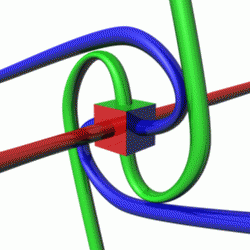It is tempting to progress to other aspects of the wave/particle duality, but these are the rambling thoughts of a “hitch-hiker” trying, one faltering step at a time, to make sense of reality, whatever that might be.
Your thoughts are fine the problem is you a dealing with a very complex thing and it won't be tamed into a 3D world as there is no effective way to deal with the angular momentum because it isn't really spinning in the classical sense.
Try to describe orbital angular momentum of spinning light in either of your schemes above. You will resort to ending up with a 3D corkscrew image that you know doesn't really match the reality but it's the best you can do. If you want to see how bad your image is, your corkscrew represents the momentum now try and draw the E/B field positions on the corkscrew. Worse than that your corkscrew has all the normal collapse and spread properties of light so now try to deal with that. Fun trying to draw a 3D spreading sphere wave corkscrewing in every direction.
Want a good laugh send the OAM light through a double slit and try and describe it

You can't work with any of the results without introducing a 4th dimension .. there is no way around it. Generally the easiest way to then represent it is turn time into a real dimension.
If you look when we try to describe light OAM
http://phys.org/news/2016-04-characterize.html "The conjugate variable of OAM, angle, is in many ways similar to phase, which is itself similar to time. So perhaps the lessons learned here can be applied, in other experiments, to systems where we need to measure time."
You can play around with descriptions like I did in extending classical physics before but there are some results you just can't explain without putting the angular momentum somewhere other than in our 3D world. This goes back to our start statement quantum spin is nothing like classical spin and so your 3D description fails.
So now we have moved from something I can make a cute Classical Physics fairytale on to something that just can't be described in classical physics.
Out of curiousity ask Prof Chris Baird to describe light OAM to you, I am interested how he deals with it Bill S. He basically gave you the same classical fairytale as me but I can't work out how to extend it to OAM other than throw my hands up. It's a like entanglement to me, I have to switch frameworks to QM to deal with it.
We are back to this problem .. how do I describe this without making time real or having a 4th dimension. I need an animation to describe it I can't draw it. That is spin 1 but a photon with OAM takes on some similar movements on the E/B fields.

You can create some cute effects by controlling the spin
https://www.sciencedaily.com/releases/2015/04/150415103314.htmIn fact, the light speeds up and slows down as it travels, periodically switching from one mode to the other. Following its helical path through space, the helix appears to wind up very tightly as it accelerates, and winds down very loosely as it decelerates. It is intriguing that by "twisting the twist," nature provides an additional momentum to the field causing it to accelerate as it spins.



